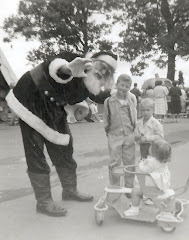 In 1977 at the age of fourteen I was asked to be Santa Claus for the Watseka Area Chamber of Commerce. It would be a position that I would hold for eight years until my high school and college education was complete. The job entailed a parade and working in a Santa House in downtown Watseka.
In 1977 at the age of fourteen I was asked to be Santa Claus for the Watseka Area Chamber of Commerce. It would be a position that I would hold for eight years until my high school and college education was complete. The job entailed a parade and working in a Santa House in downtown Watseka. In 1981, my freshman year in college, I was preparing to do the Santa gig once again for the chamber when the week before the parade, I broke my left wrist in a pick-up game of football. In my four years of high school football and four years of college ball I never got hurt, but a pick game almost sidelined my Santa career in its tracks.
I was very upset as I got the cast put on my arm. The Santa thing was done, at least for this year I thought. When the chamber found out I had a cast on, they did not panic. They suggest I find a Mrs. Claus to help lift the children.
In November of 1981, I asked DeAnn to be my Mrs. Santa Claus. She and I met in kindergarten as children and had gone through the entire Watseka School System together starting in 1968. She was the perfect choice as she was studying to be a teacher and most importantly she loved Christmas.
Thirty years have come and gone since DeAnn became Mrs. Santa Claus. She has appeared in many parades, on TV programs, at Santa’s Village, and in Santa Claus, Indiana. Three decades as Mrs. Santa Claus. I would say that there are not many Mrs. C’s out there that have done what she has done with the role and for that length of time.
Besides being Mrs. Santa Claus, DeAnn is a school teacher with 26 years with Unit 9 in Watseka, Illinois. She has two master’s degrees and numerous State of Illinois special certificates in elementary education. Beside all that and most importantly to me, today she is my real Mrs. Claus.
Thanks DeAnn for all you do for me and Santa Claus.















